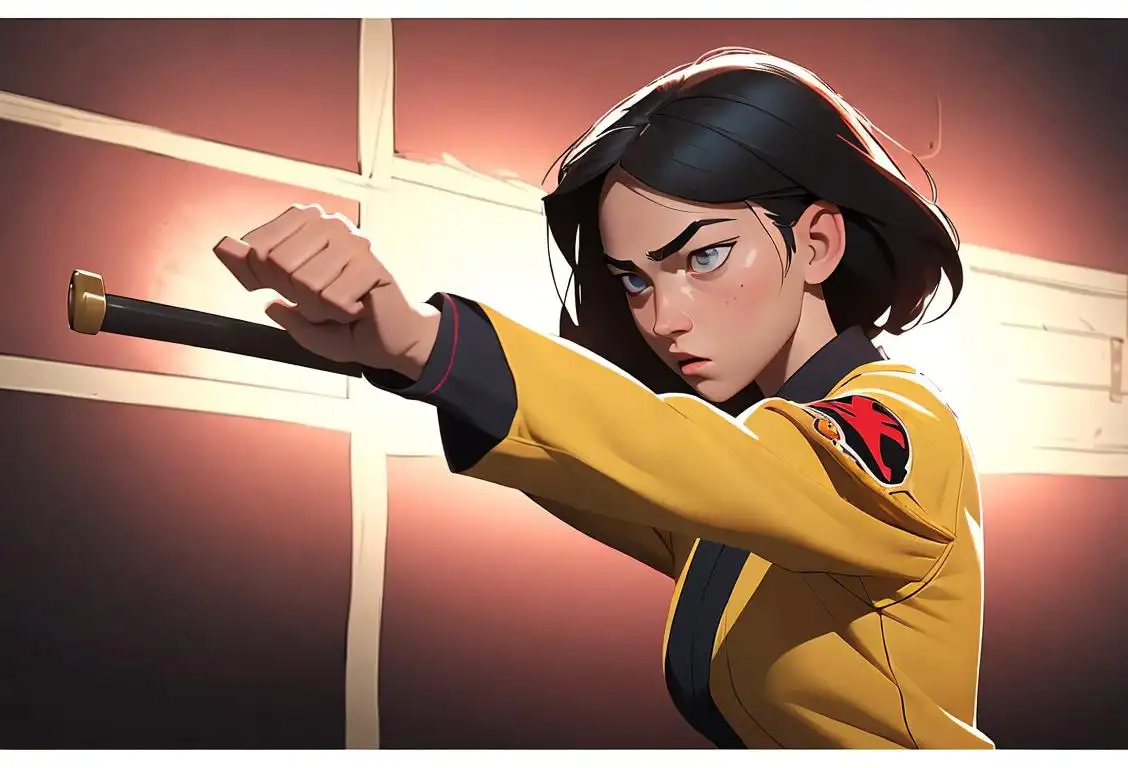National Self Defence Day

Welcome to National Self Defense Day! It's the one day of the year where we can all channel our inner Karate Kid and unleash our self-defense skills. So, loosen up those muscles and get ready to strike a pose, because today is all about empowering yourself and showing your potential attackers that you're not to be messed with!
When is Self Defence Day?
It's national self defence day on the 27th May.
Why Do We Celebrate National Self Defense Day?
National Self Defense Day is all about promoting personal safety and empowering individuals to protect themselves. With crime rates on the rise, it's important for everyone to be aware of self-defense techniques and strategies that can help them stay safe.
This special day aims to raise awareness about the different ways people can defend themselves in potentially dangerous situations. From martial arts classes to pepper spray, there are plenty of options available for individuals to learn and employ self-defense tactics to ensure their own safety and well-being.
The Internet and National Self Defense Day
The internet has played a significant role in spreading awareness about self-defense techniques and providing resources for individuals looking to learn more. Social media platforms have become a hub for sharing instructional videos and tips on self-defense, allowing anyone with an internet connection to access valuable information.
Online communities dedicated to self-defense have also formed, creating a space where people can share their experiences and offer support to one another. From forums to blogs, the internet has become a valuable tool for individuals interested in self-defense.
Fun Fact: Use Your Voice
Did you know that your voice can be a powerful self-defense tool? In addition to physical techniques, yelling, screaming, or shouting can startle an attacker and draw attention from others nearby. So, next time you find yourself in a potentially dangerous situation, don't be afraid to put your vocal cords to good use!
History behind the term 'Self Defence'
c. 600 BCE
Ancient Chinese Origins
The concept of self-defense can be traced back to ancient China, specifically during the Spring and Autumn Period. This period was marked by political turmoil and instability, which led individuals to develop techniques to protect themselves from physical harm. Early forms of self-defense were recorded in texts such as the "Ji Xiao Xin Shu," or "New Book on Military Efficiency," which outlined various defensive strategies and combative techniques.
16th century
Emergence as a legal concept
The term 'self defence' first emerged as a legal concept in the 16th century. During this time, legal systems began recognizing the right of individuals to protect themselves from harm. It was seen as a means of preserving personal safety and was often tied to the idea of acting in self-preservation.
1867
Emergence of the term 'self defence'
The term 'self defence' emerged in the legal systems of various countries during the mid-19th century. It refers to the act of protecting oneself from harm or danger through the use of reasonable force. The concept of self defence is rooted in the fundamental right to safeguard one's own life and security.
1500s
Emergence of the Term
The term 'self defence' originated in the 1500s, during the Renaissance period. It was derived from the Old French word 'defens', meaning defense or protection. At this time, self defence referred to the act of protecting oneself from physical harm or injury.
1736
Emergence of the term 'self defence'
The term 'self-defence' first emerged in 1736. It refers to the action of protecting oneself or one's property from harm or danger. The concept of self-defence has been recognized and practiced in various cultures throughout history, but it was in the 18th century that the term began to be formally used to describe the act of defending oneself.
1764
Legal Recognition
In 1764, an English jurist named Sir William Blackstone introduced the term 'self defence' into legal discourse. In his renowned work 'Commentaries on the Laws of England,' he articulated the concept of self defence as a lawful right. Blackstone stated that individuals have the inherent right to protect themselves from an imminent threat, even if it requires the use of force.
c. 460 BCE
Greek Influence: Pankration and Wrestling
Ancient Greece also played a significant role in the development of self-defense. During this period, the Olympic Games showcased various combat disciplines, including Pankration, which combined elements of boxing and wrestling. Pankration emphasized both offensive and defensive techniques, providing individuals with practical skills for protecting themselves. Wrestling, another popular sport at the time, taught individuals how to leverage their body movements for self-preservation.
18th century
Development of philosophical justifications
In the 18th century, philosophers started to delve into the moral and ethical justifications for self defence. Influential thinkers like John Locke and Immanuel Kant explored the concept of self-preservation as a natural right. They argued that individuals had an inherent right to protect themselves from harm, which further solidified the cultural impact of self defence.
1920
Development of legal frameworks for self defence
In the early 20th century, legal frameworks regarding self defence started to take shape. Governments and judicial systems recognized the right of individuals to defend themselves if threatened with unlawful violence. Laws were established to define the circumstances under which self defence could be invoked, such as the presence of imminent danger and the requirement for proportionality of force.
1830
Legal recognition of 'self defence'
In 1830, the legal system started to acknowledge the concept of self-defence as a valid defense in criminal cases. This recognition ensured that individuals who used reasonable and necessary force to protect themselves or others were not held liable for their actions. The legal recognition of self-defence contributed to the development of a framework for determining the justifiability of using force in specific situations.
19th century
Codification in legal systems
During the 19th century, self defence became more codified in legal systems. Various countries implemented self defence laws that outlined the circumstances under which individuals could use force to protect themselves. This marked an important step in the formal recognition of self defence as a legitimate legal defense.
Late 19th Century
Codification of Laws
During the late 19th century, the term 'self defence' became more formally codified within legal systems. Many jurisdictions around the world began enacting specific laws to establish the boundaries and circumstances under which self defence could be invoked. The emphasis shifted towards proportionality and reasonableness, stressing the use of only necessary force to overcome an immediate threat.
1945
Incorporation in international human rights conventions
The concept of self defence gained further prominence in 1945 with the adoption of the United Nations Charter, which recognized the inherent right of self defence against armed attacks. This principle was later reaffirmed and expanded upon in Article 51 of the United Nations Charter, allowing nations to use force in self defence until the Security Council can take appropriate measures to maintain international peace and security.
1867
Evolution of self-defence training
By the late 19th century, various forms of self-defence training began to gain popularity. Martial arts systems like Judo and Jiu Jitsu from Japan and Boxing from England emerged as effective methods for self-defence. These disciplines provided techniques and strategies to empower individuals, teaching them how to protect themselves physically and mentally.
c. 9th - 14th century
European Martial Arts and Chivalry
In medieval Europe, self-defense became intertwined with the chivalric code of conduct. Knights, nobles, and warriors were expected to possess martial skills to defend their honor and protect others. During this period, various martial arts styles emerged, such as the Germanic swordsmanship system known as "fechten," which focused on fencing and combat with bladed weapons. This era also emphasized the importance of honor, courage, and defending the weak.
Late 19th - Early 20th century
The Birth of Modern Self-Defense Systems
The late 19th and early 20th centuries witnessed the development of modern self-defense systems. Jiu-Jitsu, a Japanese martial art, gained popularity worldwide due to its effective self-defense techniques. It heavily influenced Brazilian Jiu-Jitsu, which further refined techniques for ground fighting and grappling. Around the same time, other systems like Krav Maga (developed in the 1930s) and Jeet Kune Do (developed in the 1960s) emerged, blending various martial arts styles to create practical and efficient self-defense systems.
Mid-20th Century
Expanding Interpretations
In the mid-20th century, broader interpretations of self defence started emerging. Self defence was no longer limited to physical aggression but was also seen as a justifiable response to psychological harm, emotional abuse, or threats of harm to one's property or rights. This expanded understanding acknowledged the importance of protecting oneself beyond direct physical confrontation.
20th century
Self-defence and women's empowerment
Throughout the 20th century, self-defence training became increasingly important for women's empowerment and personal safety. The rise of feminism and the women's rights movement prompted a greater focus on self-defence skills as a means of asserting independence and combating gender-based violence. Organizations and workshops dedicated to teaching self-defence to women gained prominence, emphasizing the importance of assertiveness, situational awareness, and physical techniques.
20th century
Influence of martial arts
The 20th century saw the rise in popularity and recognition of various martial arts disciplines. Practices like karate, judo, and taekwondo contributed to the cultural impact of self defence by providing individuals with specific techniques and training to defend themselves. Martial arts also emphasized discipline, self-confidence, and mental fortitude alongside physical self defence skills.
1965
Self defence as a criminal defense
Throughout the mid-20th century, the notion of self defence became a recognized criminal defense in many legal systems. It allows individuals accused of a crime, such as assault, to argue that their actions were justified as a necessary response to an imminent threat. The burden of proof typically lies on the defendant to demonstrate that their use of force was reasonable in the given circumstances.
21st century
Empowerment and self-defence movements
In recent years, self defence has taken on a broader cultural significance beyond legal and physical aspects. It has become associated with empowerment, particularly for marginalized groups such as women and the LGBTQ+ community. Self-defence movements and organizations have emerged, aiming to equip individuals with the tools and knowledge to protect themselves while fostering a sense of personal agency and resilience.
Present day
Broadening understanding of self-defence
In the present day, the concept of self-defence has evolved to encompass not only physical protection but also emotional, psychological, and digital self-defense. It recognizes the importance of setting personal boundaries, combating cyber threats, and practicing self-care to maintain overall well-being. Self-defence is now seen as a holistic approach to personal safety and empowerment, continually adapting to the challenges of the modern world.
Modern Era
Empowerment and Personal Safety
In the modern era, self defence has become increasingly associated with personal empowerment and safety. Various self defence techniques and martial arts practices have gained popularity, empowering individuals, especially women, to defend themselves and feel more secure. The term 'self defence' now encompasses not only the legal concept but also a wide range of strategies and skills aimed at promoting personal safety and violence prevention.
Present
Self-Defense in the Modern World
In the modern world, self-defense has become an essential skill for individuals seeking to protect themselves from potential harm. With the rise of mixed martial arts competitions and the accessibility of self-defense training, people have numerous options to learn effective self-defense techniques. Additionally, many countries have laws that permit individuals to use reasonable force to defend themselves or others from imminent danger, further emphasizing the importance of self-defense in today's society.
Present
Evolution and ongoing debate
In modern times, the concept of self defence continues to evolve, adapting to societal changes and legal interpretations. Different countries may have varying criteria and limits for what constitutes justifiable self defence. Additionally, debates persist around topics such as 'stand your ground' laws, which expand the boundaries of self defence in certain jurisdictions. The interpretation and application of self defence remains an important aspect of legal systems worldwide.
Did you know?
Did you know that your voice can be a powerful self-defense tool? In addition to physical techniques, yelling, screaming, or shouting can startle an attacker and draw attention from others nearby. So, next time you find yourself in a potentially dangerous situation, don't be afraid to put your vocal cords to good use!Tagged
awareness nsfw funFirst identified
27th May 2019Most mentioned on
27th May 2019Total mentions
27Other days
Children Day
Nightmare Just Day
Intelligence Richard Grenell Has Declassified A Mysterious Inauguration Day
Happiness Day
Awareness Day
Kisses Day
Opposite Day
One Day
Stormy Daniels Day
These Day









